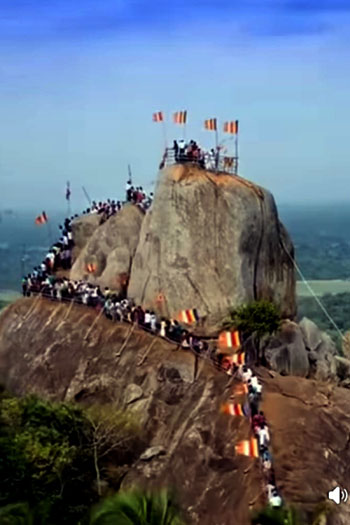Ties across the seas that changed the history of a country

Mihintale: Where King Devanampiyatissa first learnt of Buddhism, today a place of pilgrimage
India’s Emperor Asoka and King Devanampiyatissa of Lanka never met in person, but their long-distance friendship paved the way for the introduction of the teachings of Lord Buddha to this island nearly 2,000 years ago.
Their friendship had begun many years before Arahant Mahinda stepped on Mihintale rock and delivered the first Buddhist sermon to King Devanampiyatissa, the epoch-making event in the country’s history which is commemorated on Poson Poya day each year.
Much of what we know of the connection between the Emperor Asoka who ruled from Pataliputra (present day Patna in the state of Bihar in India) and King Devanampiyatissa who ruled from Anuradhapura is derived mainly from the two ancient Lankan chronicles, the Dipavamsa and the Mahavamsa, the same sources that many historians turn to for clues on their relationship.
Some writers have compared them to pen pals, others describe them as allies brought together by common strategic interests while others call it a predestined friendship that would make them the greatest patrons of Buddhism in the world.
‘These two monarchs, Dewananpiatisso and Dammasoko, though they were not personally known to each other, were united by the ties of friendship, from a long period,” according to the Mahavamsa. However, there is no clarity on when this friendship started.
Given the growing influence of Emperor Asoka particularly after his conquest of Kalinga after a protracted war, it is likely the word of his prowess on the battlefield had reached far and wide beyond the region of his conquests.
We hear of the first direct contact between the two men when in the 18th year of the reign of Emperor Asoka around 236 B.C, Tissa, the second son of King Mutasiva, is crowned king following his father’s death after a reign of 60 years. It is said that on the day of his coronation, many miraculous phenomena took place throughout Lanka with riches, precious metals and gems buried in the earth rising to the surface produced by the virtue of the piety of the newly crowned king, according to the Mahavamsa.
On seeing these precious items, the Lankan King decided that his friend Asoka, and no one else, was worthy of these treasures and decided to send a delegation to take the wondrous gifts to the Indian ruler. The mission was led by his maternal nephew Maha Arittha. The Lankan delegation carried with them three kinds of gems, three royal palanquin poles, a right hand chank, and eight ‘descriptions’ of pearls.
The journey had taken them seven days by sea and then another seven days by land to reach Pataliputra. They were well received in the court of Emperor Asoka who rejoiced on seeing them and these articles, and consulted his own ministers to decide on the proper presents to be sent in return.
According to the Mahavamsa, the return gifts were to facilitate a second coronation of the Lankan ruler and included a sword of state, a royal parasol, (golden) slippers, a head ornament (crown), a golden anointing vase, a right hand chank containing water ( to be used at the inauguration of the king) from the stream of the Ganges, a royal virgin of great personal charms, 160 loads of hill paddy which had been brought by parrots and a complete suite of royal attendants.
However, the most precious gift the Lankan delegation was given to take back with them was the gift of pious advice. “I have taken refuge in the Buddha, the Dhamma and the Sangha; I have declared myself a lay disciple in the religion of the Sakya son. Seek then even thou, O best of men, converting thy mind, with believing heart, refuge in these best of gems.”
Having resided in Pataliputra for five months, the Lankan mission departed with word from Emperor Asoka to solemnize the inauguration of his ally, King Tissa at a second coronation which took place on a full moon day of Vesak. After this coronation Tissa added the title Devanampiya, meaning the delight or the beloved of the Devas or Gods. This was a royal title that even Asoka had adopted.
In the University History of Ceylon publication (1961), S. Paranavitana in his article on ‘The rise of Buddhism in India and its introduction to Ceylon’ stated that before Tissa there was no royal consecration in Ceylon, and the fact that Tissa and his successors bore the title of Devanampiya, by which Asoka also refers to himself in his inscriptions, indicates the purpose of Tissa of sending the mission to the Mauryan court was for obtaining the consent and the support of the Indian potentate for his assumption of regal status, which his predecessors did not enjoy.
Just a month after the second consecration of the Lankan ruler, Mahinda Thera arrived on the island. According to the Mahavamsa, the meeting between Mahinda and Tissa took place at Missaka-pabbata now Mihintale, the sacred hill eight miles east of Anuradhapura, on the full moon day of Poson (May /June). There Mahinda Thera preached the Dhamma to Tissa, and the king with his retinue took refuge in the Buddha, the Dhamma and Sangha.
“Devanampiyatissa who had already heard of Buddhism from his friend Asoka received the Buddhist mission with the greatest kindness and regard,” Venerable Walpola Rahula Thera said in his book ‘The History of Buddhism in Sri Lanka’.
On his meeting the King, Mahinda first put several questions to him to gauge if Devanampiyatissa had the intelligence to understand the teachings of the Buddha and once convinced the Lankan ruler had the necessary prerequisite, proceeded to at once preach the “Chulahaththipadopama Sutta” to him and his retinue.
“The selection of this sutta by Mahinda for his first sermon was very appropriate. The sutta gives a clear idea of the Buddha, Dhamma and the Sangha and also contains almost all the principal teachings of the Buddha, such as the Four Noble Truths. Apart from general knowledge of Buddhism, it was necessary for Mahinda to convey to his host who knew nothing about Buddhist practice, an idea of the Sangha and their mode of life, so that the king might learn how to treat his new guests. At the end of the sermon, Devanampiyatissa and his retinue expressed their willingness to embrace the new faith,” Ven. Rahula wrote.
According to a compilation of Historical and Literary Studies on King Asoka and Buddhism edited by Professor Anuradha Seneviratne, Asoka’s personal commitment to Buddhism and the royal patronage which he extended to it doubtless helped to establish it in various parts of the subcontinent and in neighbouring countries. The association with Sri Lanka however was not only personal but very close, both in the sending of Mahinda and in his relations with Devanampiyatissa.
“The mission sent by Asoka to Sri Lanka is unique among his initiatives as the only one of which a full account is available and for its lasting results which are nothing less than the conversion of that country to Buddhism. In no other country to which missions were sent were the results so spectacular or lasting,” writes V.L.B.Mendis, in his book,’ Foreign Relations of Sri Lanka ( From earliest times to 1965).
Today, Asoka and Tissa are distant historical figures but their unique bond paved the way for the introduction of the teachings of Lord Buddha to the island of Lanka, where it remains entrenched firmly, more than 2000 years after Mahinda Thera preached his first sermon at Mihintale.
Searching for an ideal partner? Find your soul mate on Hitad.lk, Sri Lanka's favourite marriage proposals page. With Hitad.lk matrimonial advertisements you have access to thousands of ads from potential suitors who are looking for someone just like you.


